Here's the kit and the intended destination:
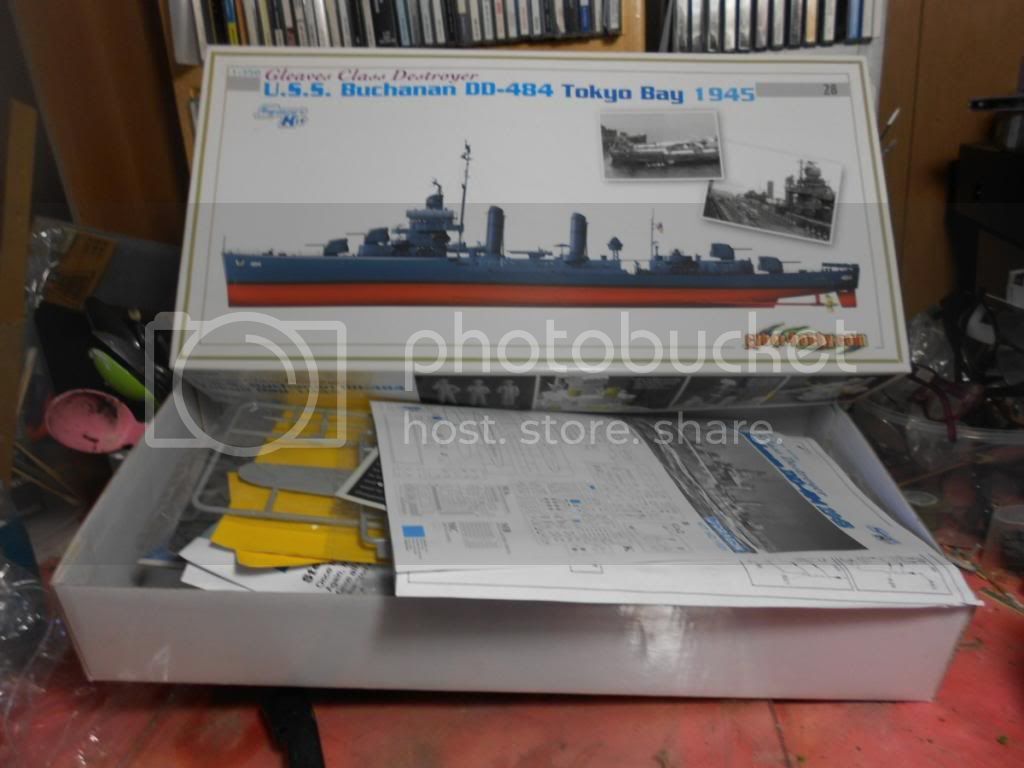
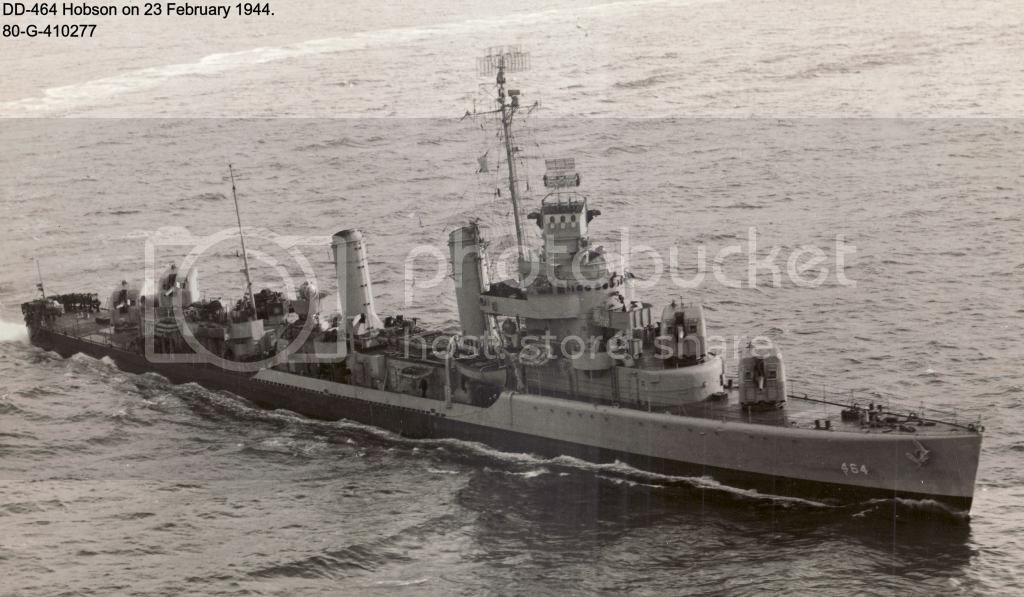
This is my first Dragon ship model, but I'm well acquainted with their armor. The family resemblance shows. The detail is exceptional for a styrene kit. In most cases the fit is also excellent. But, as is the case with their AFVs, caution is in order because a Dragon screw-up can be major, and they lurk because you don't expect them. (I'm much more cautious when building anything from Eastern Europe because I assume that you'll get bitten in the face at any time. The Tamiya portion of DML's gene pool can lull you until you get wacked by something that would do Zvezda or Smer proud.) There was also driver error involved. I started the kit in Minnesota and had to put aside for several weeks - that's a very bad way to approach a build at least for me.
More to the point, DML isn't happy if it isn't sitting at the point where many modelers would find their kits over engineered. Their designers are skilled and are able to create very detailed very small parts. Nobody will knock detail, but there are many times when one wonders if something made of three or four tiny parts couldn't have been done better with two - or one. DML's approach raises the part count and greatly increases build time. Probably the common complaint leveled at a Dragon kit are the poor instructions. Certainly true here. Parts are mislabeled, and placement is often very vague. Here is where you wish you had a Tamiya kit. Tamiya has very clear diagrams and/or photos showing what a component of the kit is supposed to look like after the parts are assembled. DML does that sometimes, and sometimes it doesn't. This leads to a lot of trial and error. I daresay that if I did another DML DD now, the build time would go down greatly. (I was dealing with two sets of instructions - one for the 1942 rendition, another shorter set detailed the changes required for the 1945 ship. It wasn't always clear where one ended and the other began.)
I should point out that I've built Buchanan while having a DML 1/350 Laffey at the ready. Most of the parts are interchangeable. I've only had to use some of the PE to replace items lost, but it's been a great comfort to know that I could take a mulligan in case of emergency. If I hit the lottery I'll make sure to have two copies of every model I build.
Anyway, as the kit stands now, most of the components are near completion. Here are several, although there is a lot of touching up to do:
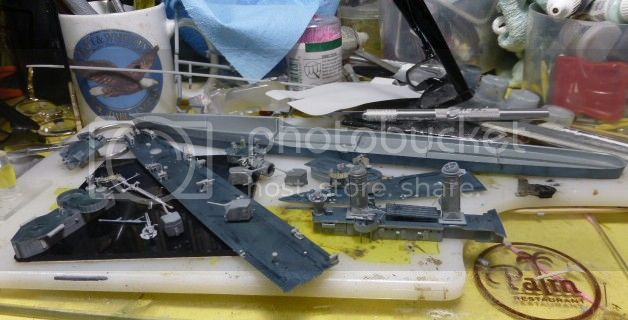
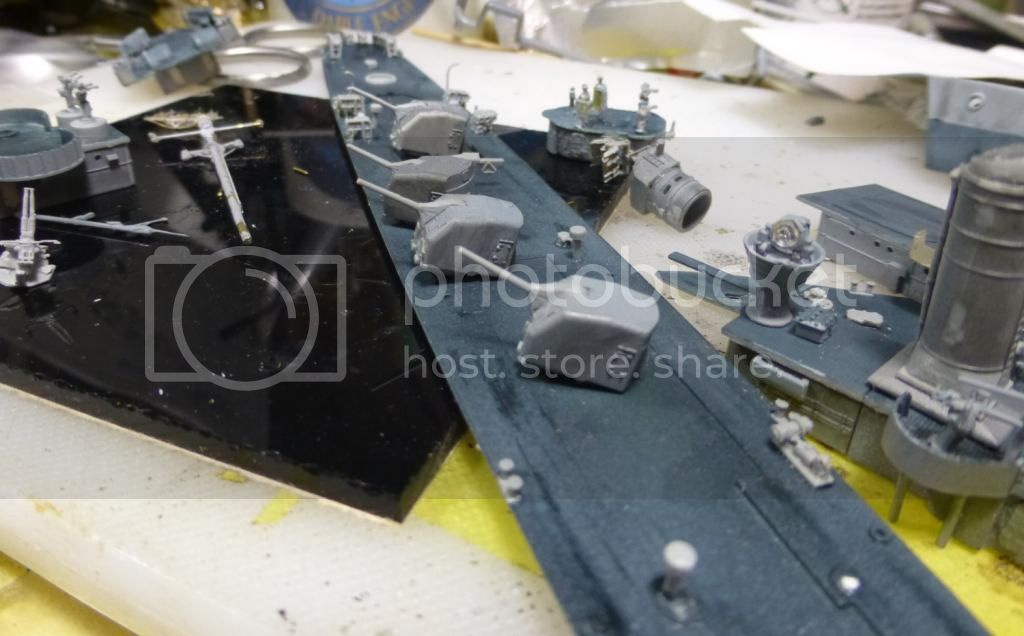
I've done some dry assembly of the components, and the fit bodes well for the final stretch - or so I hope.
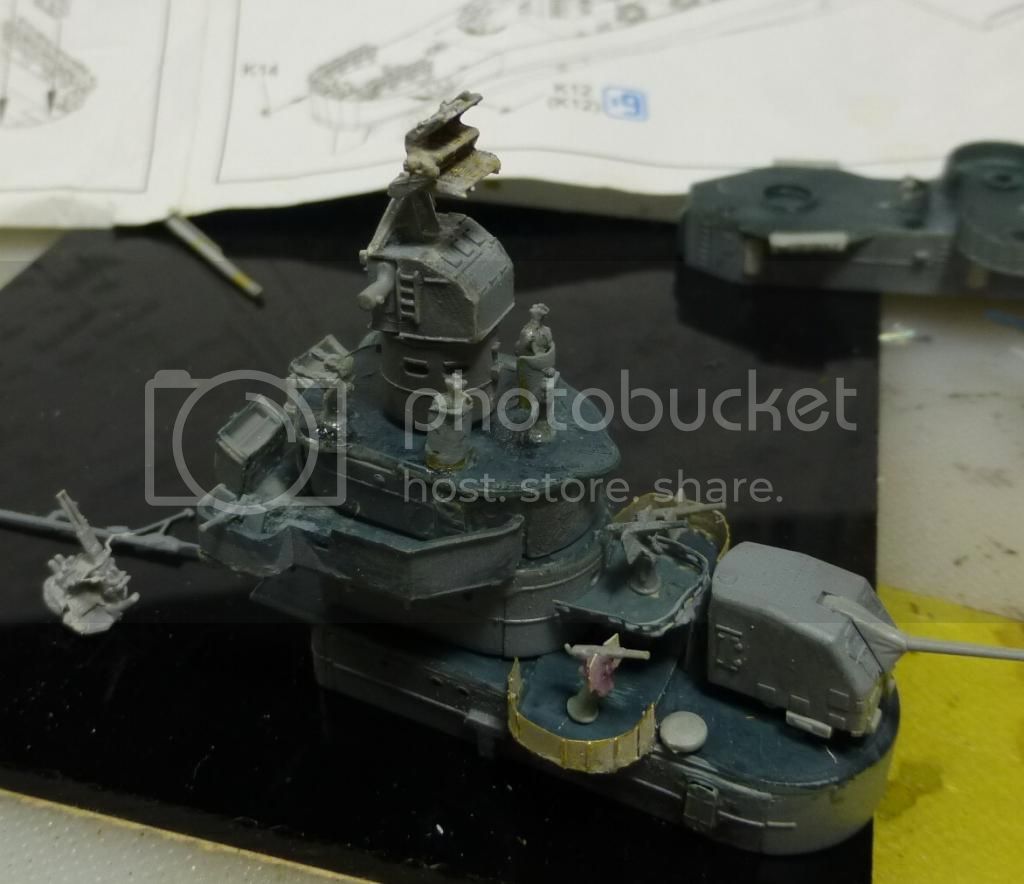
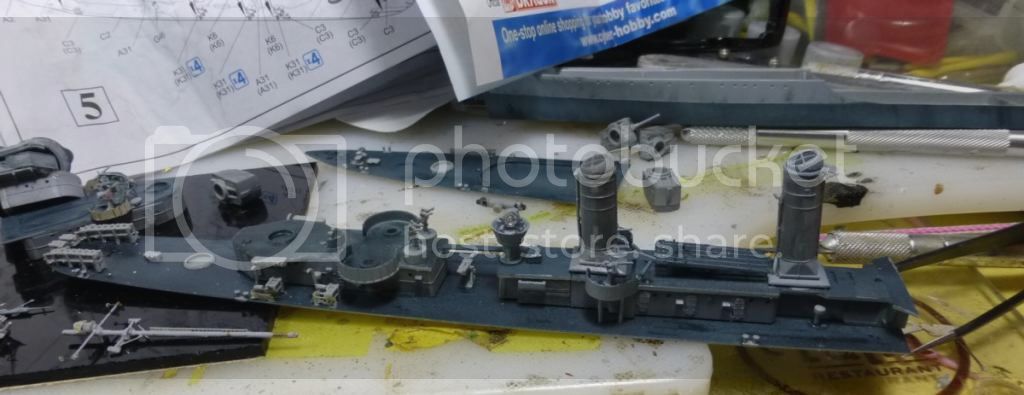
I did luck out with the PE. The standard Buchanan 42 comes with a basic set. I bought the 1945 kit second hand and it came with additional Cyber Hobby PE made for the 42 - including full railings ladders etc that look very nice. I like DML PE. It's less refined than Tom's or WEM but much sturdier. It also comes with a couple of jigs to help with some tricky bends. DML has plastic or PE choices for a number of parts, but not all. As luck would have it, the piece of PE that went AWOL was one with no plastic equivalent. With the two sets of PE included, there was no reason to track down a full set of aftermarket PE designed specifically for the kit. (I'm sure a more discerning modeler would have done so for the extra refinement.) The one place where DML let me down was the mast and the SC radar. The foremast was extremely fine and, in my few, unnecessarily segmented. I put it together and it looked very flimsy and really pretty lame. (The small mast on the aft deckhouse was pretty good and took some PE very well so I kept it. The fire control radar was done in PE and looks pretty good, although something more delicate would have been better.) The plastic SC radar was awful - something I saw right away. So I picked up a set of WEM WWII USN radars for the SC2. Nothing crude about WEM. I was a little worried about the rear frame, but actually was an easy bend and went on very quickly. I would prefer not to discuss how long it took to install the 16 dipoles in the front. (I saw another brand of radar PE - Empire I think - that dispensed with the dipoles.) Anyway, I scratched the mast in brass. Judging from the photos of the Gleaves DDs I've seen, the mast is actually pretty stout and I don't think this will be badly out of scale. The SC2 is in order - still have to work on some details.
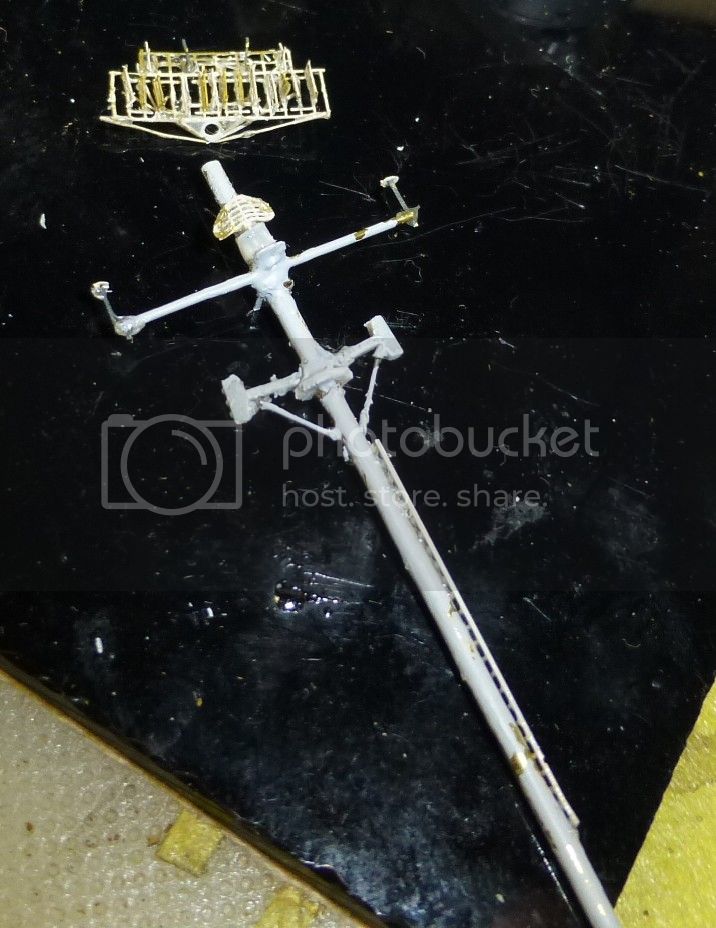
I would like to show what I'm up to with the paint job. I do a lot of armor and am very interested in the unusual but effective weathering techniques pioneered by a gent named Mike Rinaldi. (He has three volumes of his work called "Tank Art" that sell very well.) Rinaldi likes to do as much weathering as possible with shading and pigments. He argues, correctly I believe, that rust and chipping can be seriously overdone especially on allied vehicles which carried pretty solid paint jobs and tended to be only a few months old. But there's still wear so Rinaldi came up with something he calls "reverse dry brushing." What you do is lay down a base coat of a color that is close to but darker than what you want for the model. He recommends Tamiya acrylics for this stage. I used XF 17 Sea Blue after Vallejo primer for the lower hull and the pieces of the deck that I knew were going to end up blue. I sealed it with Future. The base I applied was LifeColor Deck Blue (624), LC Navy Blue both lightened with a bith of Vallejo Model Color Light Sea Gray. (I've found that LC mix perfectly well with Vallejo Model Color as both are water based acrylics with very similar painting characteristics.) Vallejo MC 905 (Blue Gray Pale) cut with MC 906 (pale blue) stood in for haze gray. Once the base colors were dry, I took a brush and dampened it in Vallejo Airbrush Thinner and slowly made some streaks. This would remove some of the light base and reveal some of the darker Tamiya. This creates a series of dark smudges. After staring at a few hundred photos of Atlantic Theater US DDs, this is what I was looking for. Hobson's history is pretty typical. After some proper fun and games with arctic convoys it returned to Boston in December 43 where I'd assume it was given a refit. It joined the Bogue "hunter killer" group and made another stop at Boston on April 2. Whatever was done was done quickly because it was dispatched to the UK where it worked with convoys near Ireland and prepared for Normandy. After service at the beaches it moved down to support ops against Cherbourg - a pretty busy ship. So overall I'd guess the Normandy DDs were in pretty good condition, but far from pristine. So this is where we're going to start - washes, filters and some streaking still to come. What I'm really going to be after is an uneven color scheme that will evoke a measure of wear (the sort of thing I see every few days when I drive by the Richmond refinery and check out the latest tanker to arrive) without a rustbucket effect. I think if you look closely at the pic of Hobson above, you'll see what I'm talking about.

The illustrator for Dave McComb's nice Osprey book on prewar class US DDs must have been thinking along the same lines. Here's a linedrawing for Landsdowne which best shows the effect. (I daresay Landsdowne was more worn than Hobson,
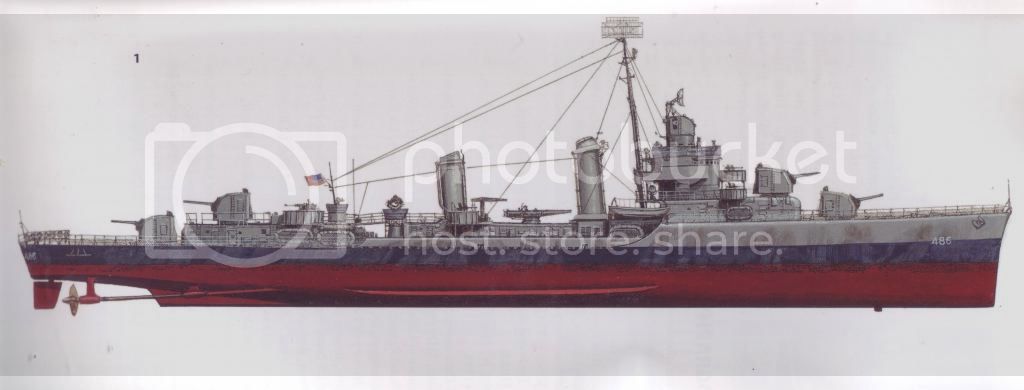
That's it for now. Will check in as things start going together which I think will happen fairly quick. Some work left, but I'm going down the hill finally - that's helpful for a modeler like myself that is prone to project fatigue.
Comments from wiser heads always appreciated.
Eric









